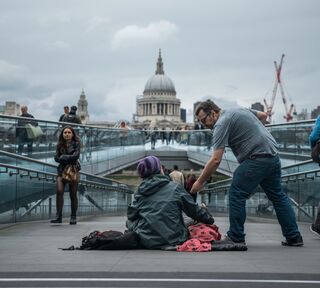Empathy
We Are All Bystanders
When a stranger needs your help, do you intervene or you walk on by?
Posted December 18, 2021 Reviewed by Gary Drevitch

At a 2003 NBA playoff tilt between the Portland Trailblazers and the Dallas Mavericks, something remarkable happened before the game even began. (This video clip reveals how it all went down.)
A 13-year-old girl named Natalie Gilbert has won a contest to sing the national anthem. There she is at center court, looking nervous, in a beautiful dress, girding herself to perform in front of 20,000 people.
She starts strong. But 20 seconds in, the wheels come off. She forgets the words. She freezes. Totally deer-in-the-headlights. Nobody knows what to do. The crowd starts sort of half-jeering, half cheering her on. It’s excruciating.
But then a stranger appears in the frame beside her – a big guy in a suit. He clamps his arm around her – which looks funny because he’s about three times her size. And he starts singing, urging her to join him.
It’s Maurice Cheeks, the Trailblazers’ coach. He does not have a good singing voice. He can barely stay in tune. But he knows the words, and together they press on, and now she’s got it again, and they’re singing together, and Cheeks does the Leonard Bernstein thing to the crowd, twirling his fingers to signal folks to join in. They do, and pretty soon the whole arena is swept up in the moment. Everybody is singing: the fans, the players, the coaches – and at the end, the girl belts out the final notes with a flourish and collapses into Cheeks’ chest, and he gives her a hug and returns to his bench.
Mo Cheeks is a Hall-of-Fame point guard. But to many casual basketball fans this is his legacy, the instant that defines him not as an athlete but as a human.
So why did he do it? There were 24 players lined up on the court within a few feet of Gilbert, and three referees, and none of them moved. Cheeks himself had no great insight into why he did what he did. He didn’t even think, he told reporters afterward — he just reacted. It was like a reflex.
****
Someone put me onto that story by chance, but the timing couldn’t have been better. Bystander intervention is in the air right now. Many workplaces are offering a version of bystander-intervention training as part of their anti-racism efforts, and schools are investigating it in the context of anti-bullying.
Broadly speaking, bystander-intervention work is about preparing us to be active agents of change rather than passive onlookers. That’s the harder road, but only at first. Once we wake up to what’s going on under our noses — say, someone being harassed or belittled or public – we feel a kind of moral duty to jump in, and it actually becomes less uncomfortable to do that than to stand idly by. This circumstance is a bit different from the Mo Cheeks example, above, because there’s a third person in the mix — an oppressor — and the art is to intervene without escalating an already volatile situation. But here’s what’s the same: The victims often report that what stings most isn’t the initial affront – it’s the silence that follows. Like: This thing happened and nobody did anything. I was left to twist in the wind.
When we’re out in public and see someone in trouble, there are lots of reasons to talk ourselves out of helping. Princeton psychologists Bibb Latané and John Darley identified three:
- Diffusion of responsibility. You figure someone else is going to step in.
- Embarrassment. You fear being judged.
- Social proof. You pick up the cues – since no one else is doing anything – that intervening isn’t appropriate or possible.
But it turns out there’s another factor that’s often a powerful determinant of whether we intervene or don’t. This one was beautifully exposed in Darley and Batson's classic “Good Samaritan” study. The subjects here were seminary students. The experimenters contrived a scenario in which, while walking from one end of campus to the other, the students would happen across a man on the sidewalk in obvious distress. And the students were primed to help — they were on their way to give a speech about the parable of the Good Samaritan! But only some of them stopped. Many walked right past the man. The difference? Time. The students who hustled on by were running behind schedule. They couldn’t afford to take time for this unanticipated stop. They were too busy to be benevolent. Feeling rushed, the psychologists surmised, kills empathy – or at least our ability to put feelings of empathy into productive action.
****
One small upside of the pandemic is that the disruptions have forced a lot of people to retreat into their caves, take stock of their overstuffed, overprogrammed, overstressed lives, and reflect on just what we all give up in the bargain – relentless material striving at the cost of feeling rushed all the time. Our circle of concern tightens around ourselves and our immediate family. The question is: When we’re too busy to get involved in the business of other people’s lives – the skirmishes, the injustices, the simple help-me-out moments — does that make us a little less human?
On the night of that basketball game in 2003, Maurice Cheeks was no less ... busy than everyone else on the court who could have stepped in to help the struggling anthem singer but didn’t. He was no less preoccupied. But there was one thing: Almost as an aside, in the press scrum, Cheeks mentioned that he had a daughter about the same age as Natalie Gilbert. So maybe it was a kind of Papa Bear instinct kicking in. At some level, he ventured, the girl he saw out there who needed rescuing was Maura, his own daughter.
Maybe that’s what bystander-training intervention is really all about: The skill we’re cultivating is the sensitivity to see ourselves in each other.




